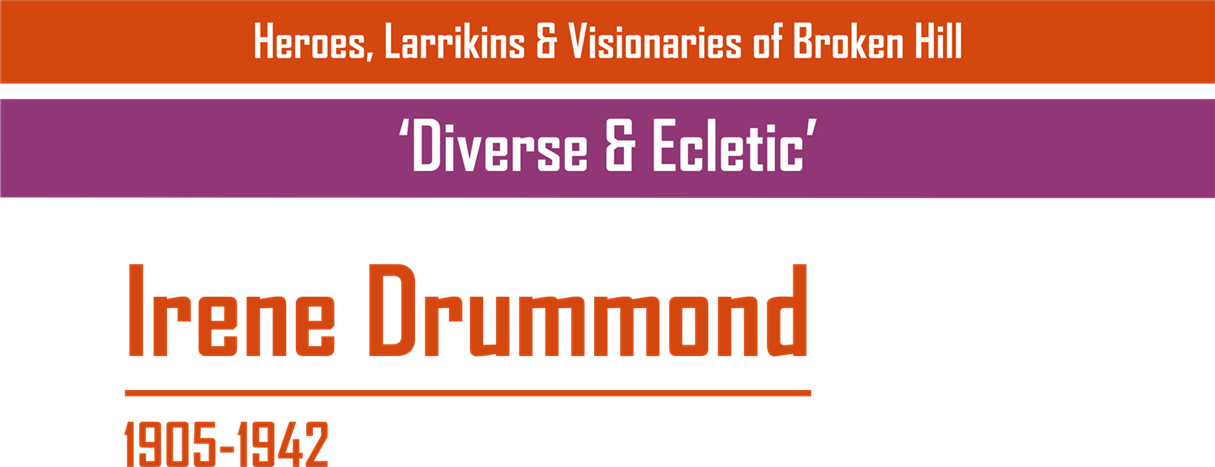Irene Drummond

Irene Drummond, army matron and gifted WWII nurse, was acknowledged for ‘gallant and distinguished behaviour in Malaya’ in 1946, four years after her heroic death at the age of 36. Drummond was one of the 22 nurses murdered by the Japanese army in the tragedy that is now known as the Bangka Island Massacre.
Irene Drummond was born at Ashfield, Sydney and educated in Adelaide and Broken Hill. She trained as a nurse in Adelaide, first at Miss Laurence’s Private Hospital, then qualified in Obstetrics at Queen’s Hospital, before working in Obstetrics at Angaston Hospital in South Australia. She returned to Broken Hill in 1933, aged 28, and worked as a surgical sister at the Broken Hill and District Hospital. Irene’s skill and efficiency earned the respect of her colleagues and senior hospital staff, and she was promoted to assistant matron, then to acting matron before enlisting in the army during WW11.
As a member of the Australian Army Nursing Service (AANS), an Army Reserve unit formed in 1902, Irene was also a volunteer civilian nurse trained for military nursing duties. She enlisted in November 1940, though was given the opportunity to resign from the Army to return to Broken Hill as matron of the city’s hospital. She refused, saying she believed she should be with ‘her girls’. Part of the Australian Imperial Force, the nursing sisters in the AANS sailed for Singapore in February 1941 to join the Field Ambulance service. By August Irene was promoted to Matron and posted to the Australian General Hospital, a mobile unit that went where it was needed in southern Malaya. When the Japanese invaded Malaya, the unit fell back, setting up in St. Patrick’s School in Singapore. Irene Drummond ran the ward amidst air raids, under incredibly difficult conditions and non-stop war casualties – always brave, calm and compassionate.
The AANS left Singapore on 12th February 1942 bound for Australia, only days before the island fell to the Japanese Army. Their transport was the steamer Vyner Brooke, the Royal Yacht of Sarawak. Two days later the Vyner Brooke was bombed by Japanese aircraft in Bangka Strait and sank. About 100 passengers survived, including civilians, wounded soldiers, and 22 nurses – amongst them two Broken Hill nurses: Vivienne Bullwinkel and Irene Drummond.
The Vyner Brooke survivors were washed up on Radji Beach on Bangka Island, off Sumatra, and joined British servicemen from another bombed ship. Irene, the most senior Australian nurse, and her band of sisters did what they could to dress wounds and tend to the injured. It was agreed that the only way to survive was to surrender to the Japanese Army who now controlled the island, and a delegate was dispatched to negotiate a surrender. But before any negotiation could take place, a Japanese officer and 20 soldiers arrived on the beach and ordered all the men at gunpoint to a nearby cove where they were bayonetted and shot.
When the Japanese returned to the beach the nurses knew what would happen next. They were raped and then ordered to walk into the sea where they were machine-gunned. Only Vivienne Bullwinkel survived by feigning death. Years later, in memory of Irene Drummond, Vivienne Bullwinkel said: ‘Her calmness and bravery in face of danger and death will remain with me as long as I live.’ After her rescue from the Bangka Island prison camp three years later, Bullwinkel reported that Irene Drummond’s last words were: ‘Chin up, girls. I'm proud of you and I love you all.’
Audio transcript available.
PICK UP YOUR FREE BROCHURE & MAP OF THIS TRAIL FROM THE VISITOR INFORMATION CENTRE